Note
Notes and comments on the distribution of two endemic Lygosoma skinks (Squamata: Scincidae: Lygosominae)
from India
Raju Vyas
505, Krishnadeep Tower, Mission Road, Fatehgunj, Vadodara, Gujarat 390002, India
razoovyas@hotmail.com
doi: http://dx.doi.org/10.11609/JoTT.o3906.6726-32 | ZooBank: urn:lsid:zoobank.org:pub:41964DD1-ED88-4DE7-BFD1-8763B0F69714
Editor: C. Srinivasulu, Osmania University, Hyderabad, Telangana, India. Date of publication: 26 December 2014 (online & print)
Manuscript details: Ms # o3906 | Received 06 January 2014 | Final received 13 November 2014 | Finally accepted 27 November 2014
Citation: Vyas, R. (2014). Notes and comments on the distribution of two endemic Lygosoma skinks (Squamata: Scincidae: Lygosominae) from India. Journal of Threatened Taxa 6(14): 6726–6732; http://dx.doi.org/10.11609/JoTT.o3906.6726-32
Copyright: © Vyas 2014. Creative Commons Attribution 4.0 International License. JoTT allows unrestricted use of this article in any medium, reproduction and distribution by providing adequate credit to the authors and the source of publication.
Funding: None.
Competing Interest: The authors declare no competing interests.
Acknowledgements: I am grateful to Late Dr. B.H. Patel and Kartik Upadhayay for accompanying me during the field work. I am specially thankful to Maheshdan Gadavi and Nitin J. Patel (Vadodara) for sharing information and providing me rescues specimens for examined and photographs. Thanks, Snehal S. Patel, President, Nature Club, Surat for the logistic and transport supports during Dangs forest trips. Finally, I am grateful to Khushboo R. Vyas for preparing the draft and drawing maps for the manuscript.

The family Scincidae is the largest group among lizards, comprising more than 1558 species (Uetz & Hosek 2014). Of the seven subfamilies recognized, the subfamily Lygosominae contains over 52 species in five genera (Uetz & Hosek 2014). The genus Lygosoma Hardwicke & Gray, 1827 has a long and complicated nomenclatural history (see Geissler et al. 2011). In India, the genus Lygosoma is represented by nine species, of which five are endemic (Datta-Roy et al. 2014), including Günther’s Supple Skink Lygosoma guentheri (Peters, 1879) and the Lined Supple Skink Lygosoma lineata (Gray, 1839). These are less studied, terrestrial, insectivorous and diurnal supple-skinks (Molur & Walker 1998). Both these species are found in peninsular India and are classified ‘Least Concern’ species by the IUCN Red List of Threatened Species (Srinivasulu & Srinivasulu 2013a, b).
Reserved forest and degraded areas of the northern ends of the Western Ghats, especially the border areas of Vyara and Dangs districts (Gujarat) and Nasik District (Maharashtra) were explored during 2012 and 2013, and a small number of specimens of supple-skinks studied. Two fresh skink specimens of L. lineata and L. guentheri were collected from the outskirts of Vadodara City, Vadodara District and after examination both the skinks were released in the nearby riverine habitat of Vishwamitri River within the limits of the city area.
Lygosoma guentheri: On 12 December 2013, a large adult specimen of Lygosoma (Image 1) was captured by a local rescue group from a garden in Vadodara City, Gujarat. The specimen was identified as L. guentheri with the help of the literature (Boulenger 1890; Smith 1935). The morphometric data and other information of the specimen are mentioned in Table 1.
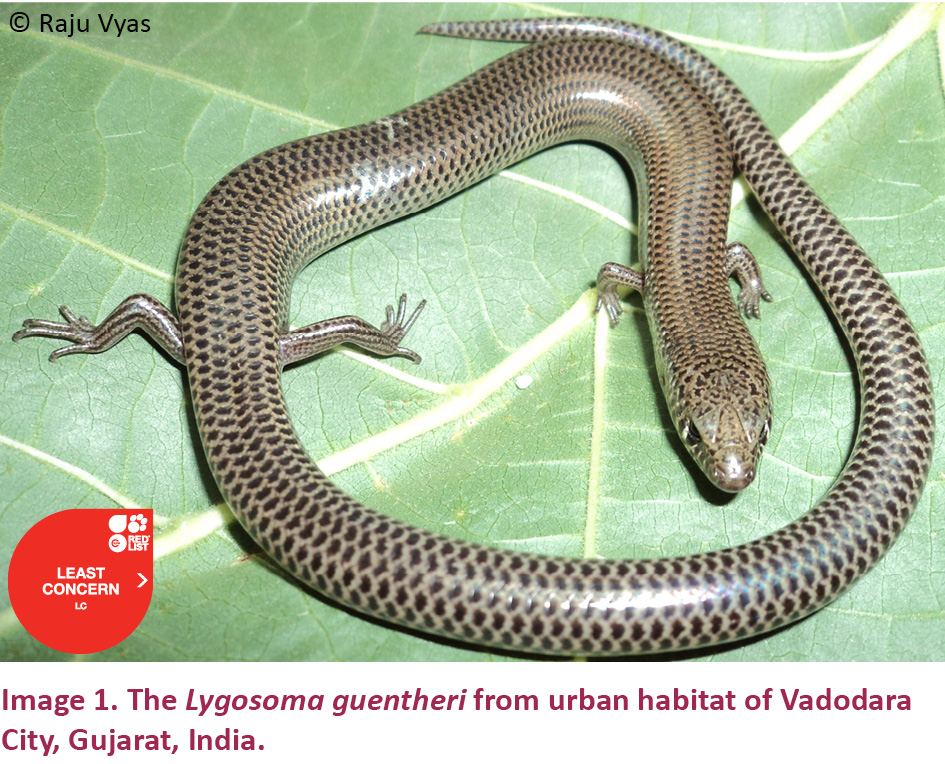
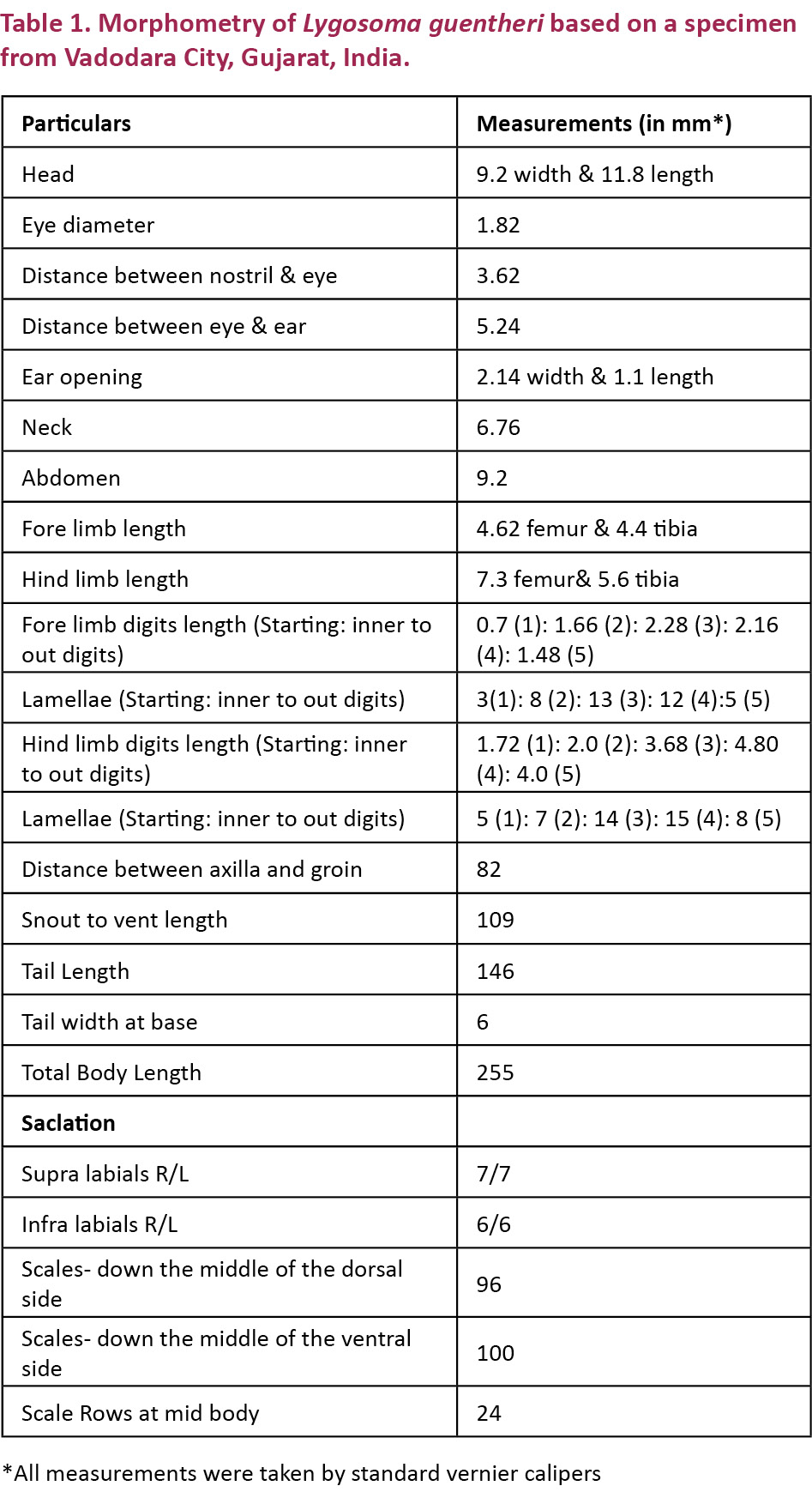
The Lygosoma guentheri is closely allied to Lygosoma punctata (Gmelin, 1799), but distinctly differs as follows (L. guentheri vs L. punctata): the distance between the axilla and groin measures three to three-and-a-half times the length between snout to fore-limb (vs. distance between the axilla and groin measures two to two and three-quarter times the length between snout to fore-limb); the ear-opening is small without lobules (vs. ear-opening is half of the eye-opening with one or two small lobules anteriorly); 24–26 scales round the body and 87–100 scales on mid-dorsal region (vs. 24–28 scales round the body and 62–76 scales on mid-dorsal region); the ad-pressed limbs fail to meet by three to four times the length of the fore-limb (vs. ad-pressed limbs fail to meet by twice the length of the fore-limb) (Boulenger 1890; Smith 1935).
The largest specimen of Lygosoma guentheri measured 250mm long (105mm snout to vent + 145mm tail) (Boulenger 1886). The present specimen measured 255mm in length (Image 2) (10.9cm snout to vent + 14.6cm tail), which is a little larger than the previous records, but the snout to vent length is smaller than the specimen collected by Vyas (2006) from Gamadi Village, Chanod, Vadodara District (BNHS specimen no. 1561, total length 818mm with 127mm snout to vent +691mm tail length).
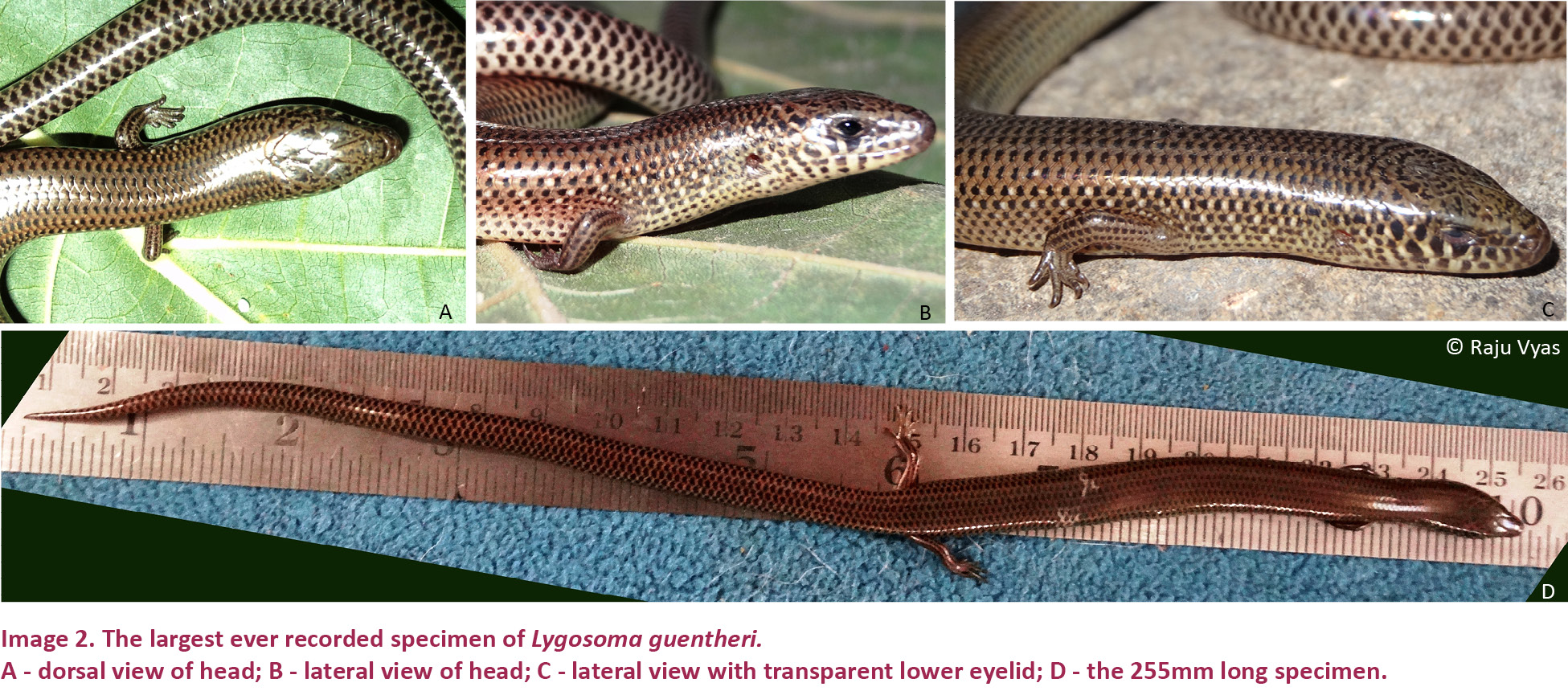
This species inhabits a wide range of habitats; forests to scrub lands and agricultural fields to urban gardens. The species is common at most of the tabletop mountains (plateaus) of the northern Western Ghats, found in areas with sparse grass and shrubs on a rocky terrain (Image 3). It is most often found under large boulders and in loose soil during the rainy season. This species is found, less-common to rare, in low elevated plain areas of forests, agriculture lands and urban gardens, too.
Lygosoma lineata: The L. lineata (Image 4) was originally described as Chiamela lineata from India without any specific locality. Boulenger (1887) allocated the species to the genus Lygosoma. On 25 November 2013, a sub-adult specimen of Lygosoma was captured by a local rescue group from the outskirts of Vadodara City, Gujarat. The specimen was identified as L. lineata with the help of literature (Boulenger 1890; Smith 1935). Earlier, a few specimens were studied from various locations within Gujarat State (Table 2), except the Kutch and northern Gujarat.
The L. lineata body is long, thin and very slender. This skink is differentiated from other co-members by having four fingers in the limbs (vs. five fingers). It is very similar to its closely allied species L. vosmaerii (taxonomically debatable species, see Vyas 2010, Srinivasulu & Seetharamaraju 2010). L. lineata has four fingers and four toes, whereas L. vosmaerii has five fingers and four toes (Smith 1935; Seetharamaraju et al. 2009; Srinivasulu & Seetharamaraju 2010). The body is very slim, the distance between the axilla and groin measures three to four times the length between the snout and fore-limb.
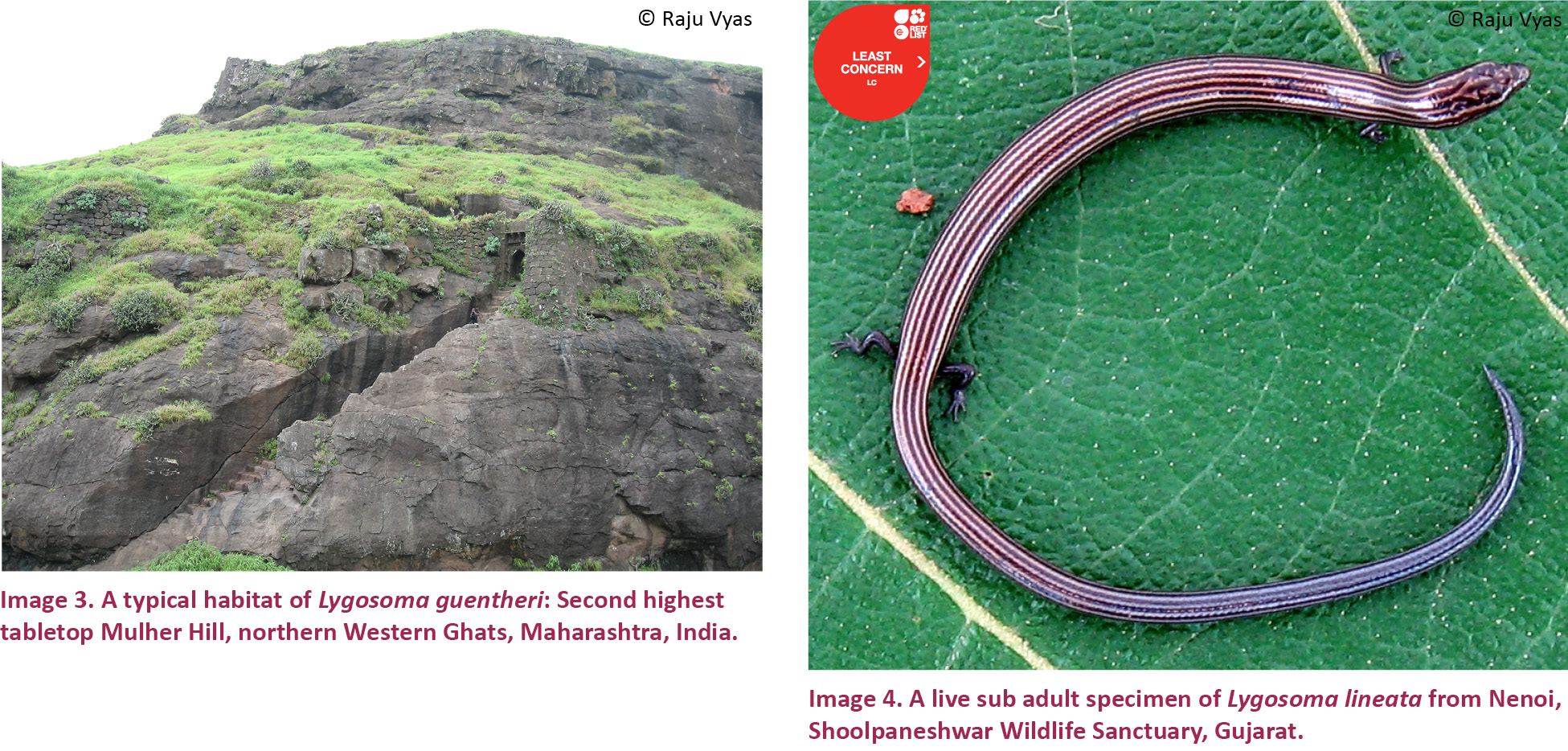
This species occurs in various types of habitats, including wet deciduous to dry, thorny deciduous, scrub and rocky to saline grasslands and agricultural fields to urban gardens. It is usually found under boulders, rotten logs and layers of dry leaf litter. Its subterranean life style, habits and habitat are entirely special, and they contribute to its rarity (Molur & Walker 1998).
Lygosoma guentheri is distributed in Gujarat (Acharya 1949; Daniel 1962; Vyas 2006), Maharashtra (Chopra 1964; Vyas & Prjapati 2010), Goa (Sharma 2002), Karnataka (Ali et al. 2006; Datta-Roy et al. 2014), Andhra Pradesh and Telangana (Rao et al. 2005; Srinivasulu & Das 2008; Javed et al. 2010) in India. The occurrence of the species in Kerala (Sharma 2002) was questioned by Javed et al. (2010) with a statement ‘needed to confirm the occurrence of this species in Kerala’, though there are three specimens (ZSI No. 4371, 4374 & 4375) from the Travancore Coast in the museum of Zoological Survey of India (Sharma 1982). The species is more widely distributed in seven Indian states, namely, Gujarat, Maharashtra, Goa, Karnataka, Kerala, Telangana and Andhra Pradesh. The ‘Catalogue of specimens of reptiles in the collection of the Natural History Museum of Stanford University’ (California Academy of Science, Herpetology Collections, USA) shows there are a few Indian reptiles in the collection. This collection was deposited by A.W. Herre (13 December 1940) and specimens were collected from Bisarampur, Central Province, (before 2000, the area was a part of Bihar, now lies in Palamau District, Jharkhand, India), including two specimens of L. guentheri (CAS-SU-Rep No. 11007 and 11008, Fig. 1), but none of the publications mentioned the distribution of the species from Jharkhand, India (see Sharma 2002; Vyas 2006; Javed et al. 2010). The collection site Bisarampur, Jharkhand is about 100km from the closest known southern locality of Bhimaram, Telangana (Javed et al. 2010). The forest types and habitat areas lying in between these two localities are potential and similar, especially the forest areas of Chhattisgarh State. Surprisingly, no records from Chhattisgarh and Madhya Pradesh have yet been published (Chandra & Gajbe 2005).
Lygosoma lineata also occurs in Jharkhand. The ‘Catalogue of specimens of reptiles in the collection of the Natural History Museum of Stanford University’ (CAS, Herpetology Collections, USA) includes a specimen of L. lineata (CAS-SU-Rep No. 13653, Fig. 2) collected by A.W. Herre (13 December 1940) from Bisarampur, Central Province (now in Palamau District, Jharkhand, India). The collection site Bisarampur, Jharkhand is at a distance of 600km north from the closest known locality Nagpur, Maharashtra from where L. lineata is reported. The forest types and habitat areas in between these two localities have similar topography, climate and forest type, and are potential habitats, especially the forest areas of Chhattisgarh and Madhya Pradesh. Surprisingly, there have been no records of the species from Madhya Pradesh (Chandra & Gajbe 2005), excepting the comments of Chari (1960). The species was conspicuously missing from the species lists of Madhya Pradesh (including Chhattisgarh State) and Bihar (including Jharkhand) (see Chari 1960; Sharma 2002; Vyas 2009; Mirza et al. 2010). Bisarampur, Jharkhand locality marks the northern most point of the species in its range.
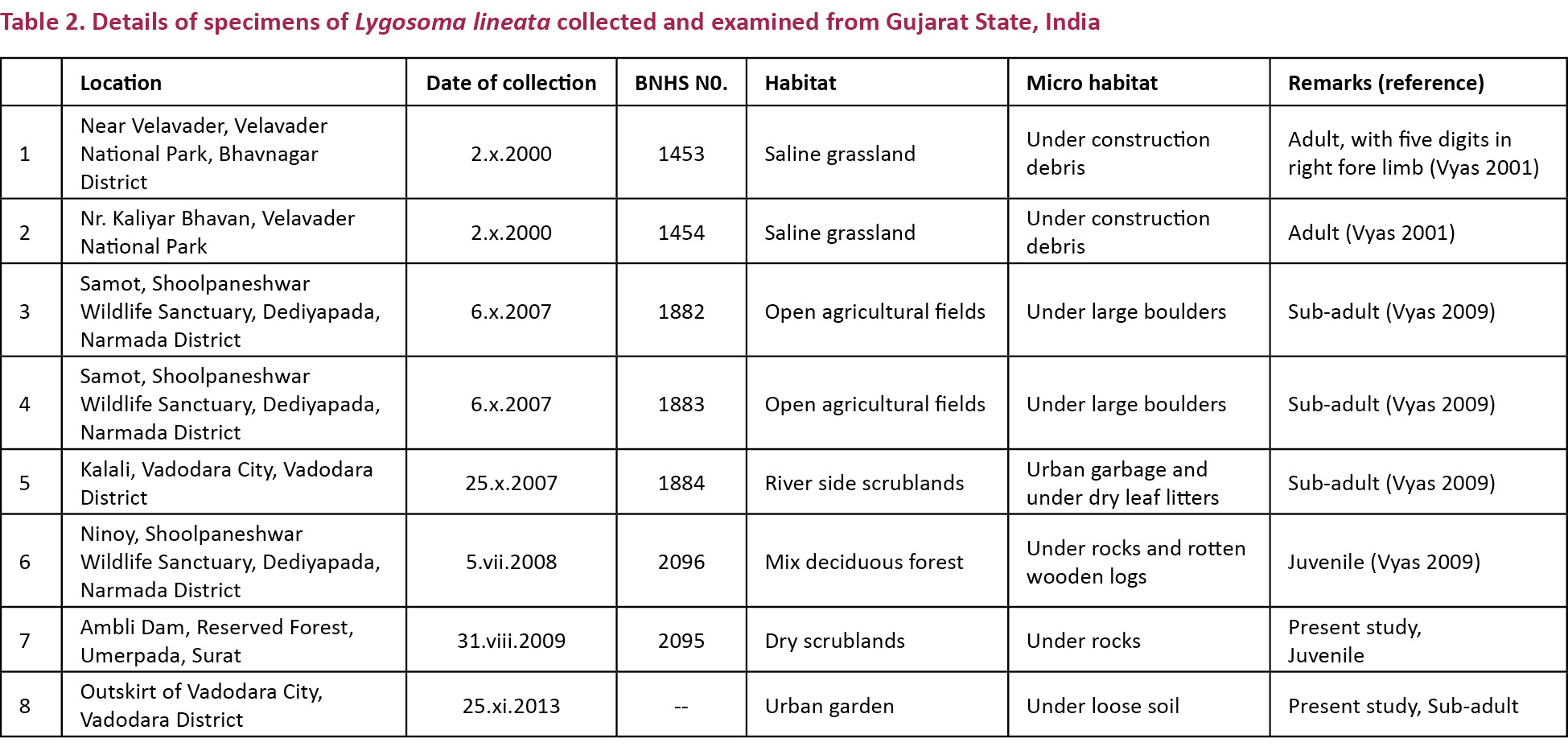
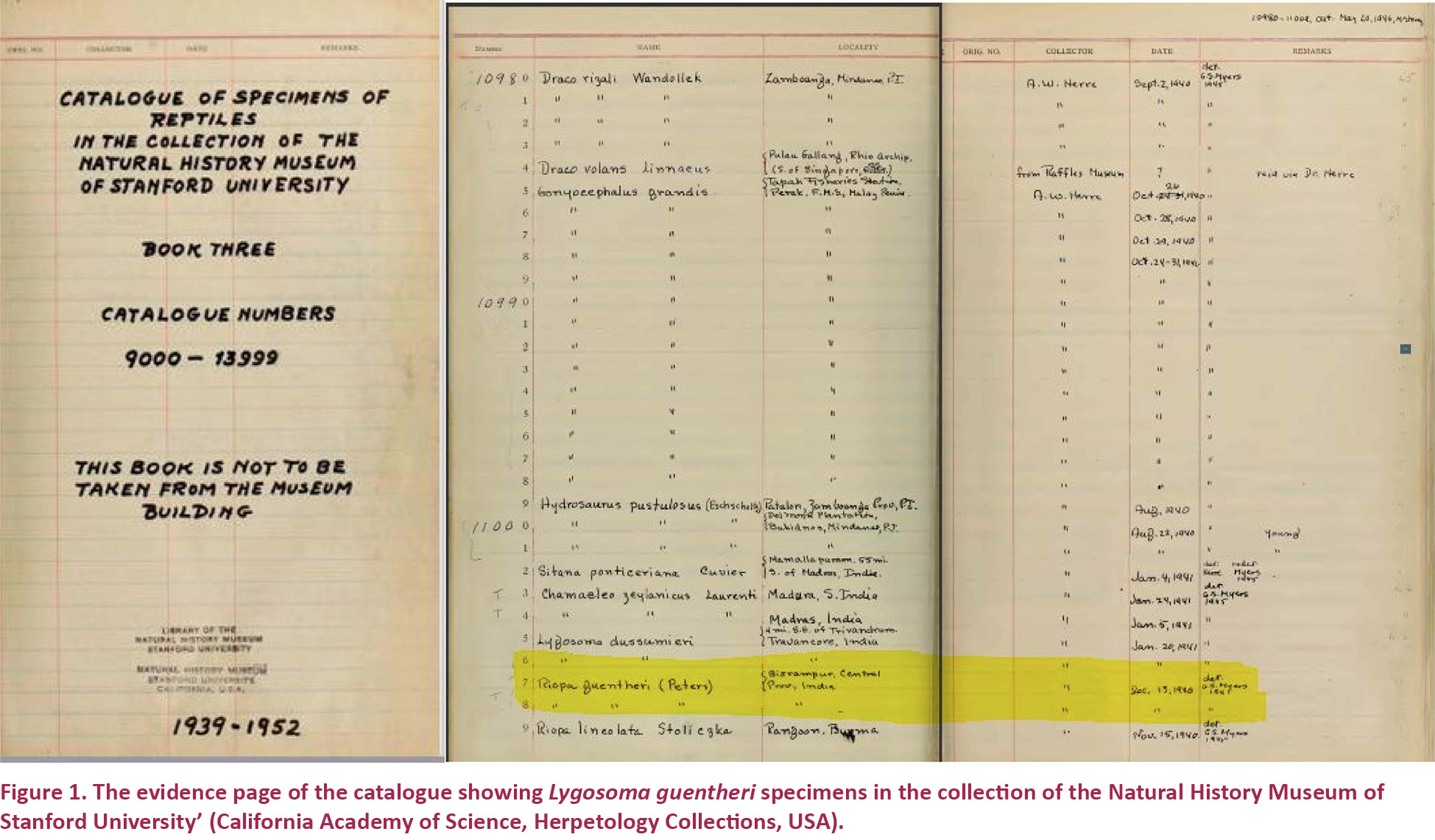
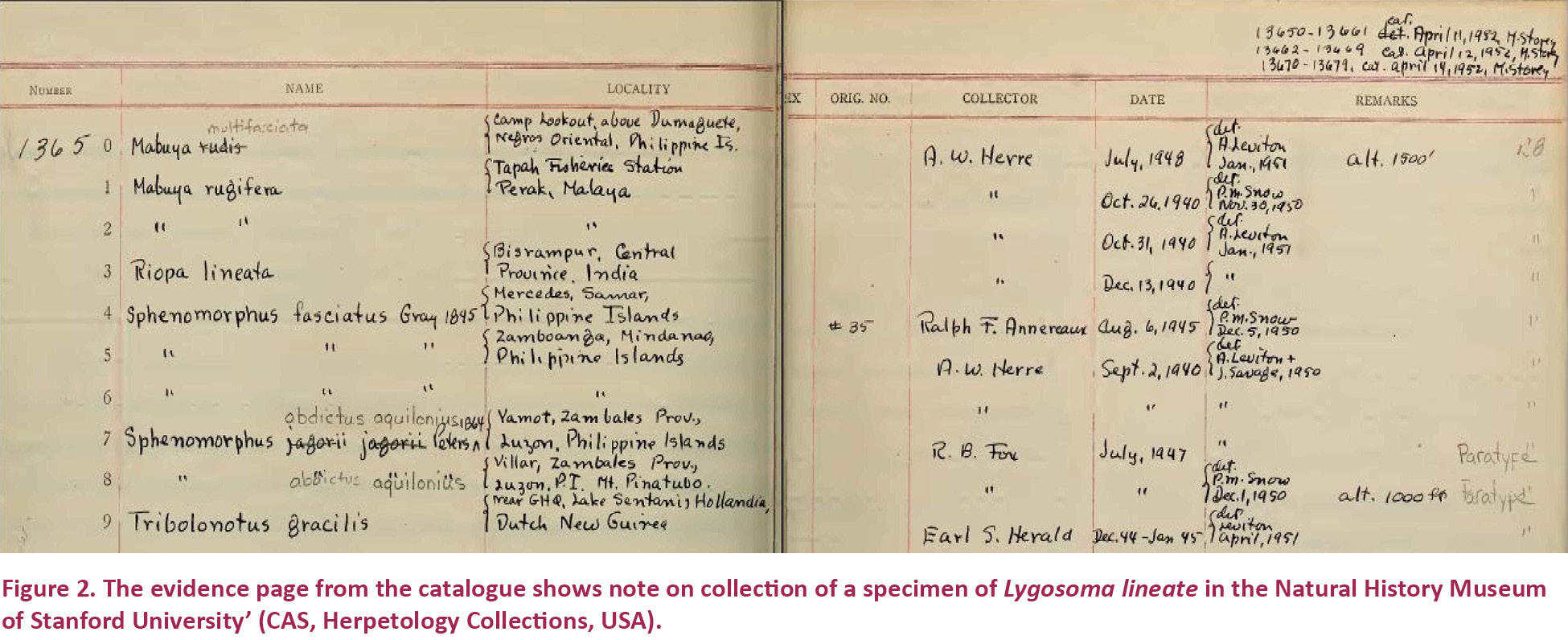
The hitherto literature survey indicates, distribution of the species being very wide and scattered in peninsular India, with the most western distribution limits marked at Rajkot, Gujarat (Vyas 2009), southern distribution limits in Chidambaram, Tamil Nadu (Chari 1960) and the northern end limit in Bisarampur, Jharkhand. But, as yet there is no report from the states of Chhattisgarh (Chandra & Gajbe 2005) and Andhra Pradesh (Rao et al. 2004; Srinivasulu & Das 2008), even though a similar forest habitat structure is prevalent in both the states. Vyas (2009) suggested the possible occurrence of this species in Madhya Pradesh, on the basis of L. lineata population available in Shoolpaneshwar Wildlife Sanctuary, Gujarat and similar potential habitat tracks existing on the entire interstate boundary of Gujarat, Maharashtra and Madhya Pradesh, and a preserved specimen (no specific locality) from Madhya Pradesh in the museum of Zoological Survey of India (Chari 1960). The specimen from Bisarampur, Jharkhand strongly supports the species occurrence in Chhattisgarh and Madhya Pradesh. The habitat and forests areas of Telangana and Andhra Pradesh are most potential and climatically similar with the adjoining states, from where L. lineata is reported. The forest habitat in Andhra Pradesh also, supports other members of Lygosoma, including L. vosmaerii (Seetharamaraju et al. 2009).
The altitude distribution of the L. guentheri is observed from 15m (Valsad Town, Gujarat) up to 1600m (Kalsubai, Maharashtra), in the Western Ghats. The altitude distribution of L. lineata is from 2m at the saline grasslands of Velavadar National Park, Bhavnagar District, Gujarat (Vyas 2001) up to an elevation of 630m in the mix deciduous forest of Melghat Tiger Reserve, Satpura mountain, Maharashtra (Narasimmarajan & Mahato 2013). The published literature and present information indicate that L. guentheri and L. lineata seem to be much more widely distributed than currently known (Figs. 3 & 4).
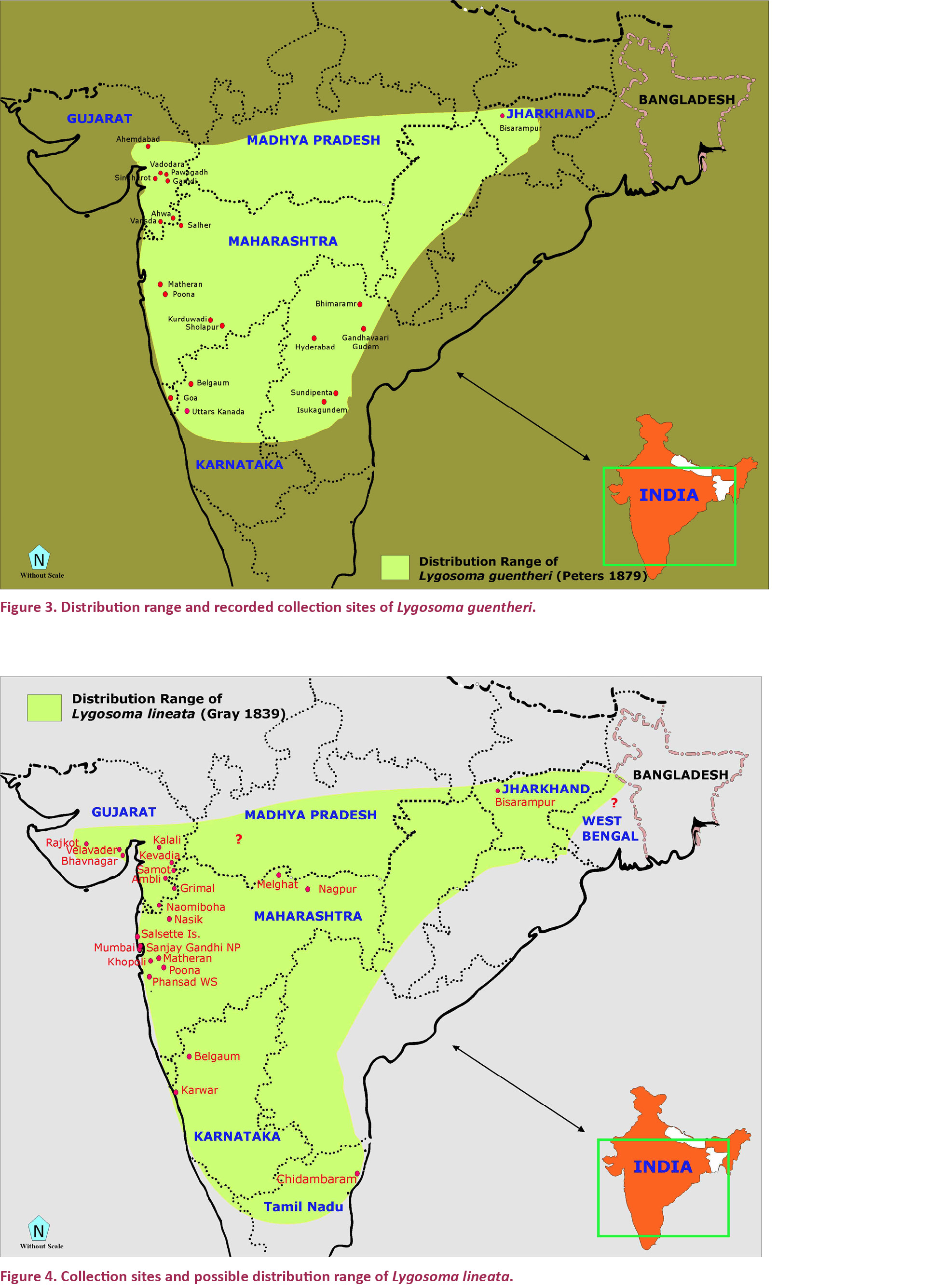
References
Acharya, H.N. (1949). List of reptiles from Gujarat State, Prakurti 8: 156–178 (in Gujarati).
Ali, S., M.D.S. Chandran & T.V. Ramachandra (2006). Faunal assemblages in Myristica swamps of Central Western Ghats, Karnataka, India. In: Anon. (ed.) Proceedings of the Symposium on Environment Education & Ecosystem Conservation. Indian Institute of Science, Bangalore.
Boulenger, G.A. (1887). Catalogue of the Lizards in the British Museum (Natural History). Vol. III. Taylor and Francis. I-XL pls+566pp.
Boulenger, G.A. (1890). The Fauna of British India, Including Ceylon and Burma. Reptilia and Batrachia. Taylor & Francis, London, xviii+541pp.
Chandra, K. & P.U. Gajbe (2005). An inventory of herpetofauna of Madhya Pradesh and Chhattishgarh. Zoos’ Print Journal 20(3): 1812–1819; http://dx.doi.org/10.11609/JoTT.ZPJ.1087.1812-9
Chari, V.K. (1960). Distribution of the skink Riopa lineata Gray. Journal of the Bombay Nature History Society 57: 226.
Chopra, R.N. (1964). Notes on some lizards of Poona. Journal of the University of Poona (Science & Technology) 28: 39–42.
Daniel, J.C. (1962). Extension of the range of the skink Riopa guentheri (Gray). Journal of the Bombay Natural History Society 59(3): 965.
Datta-Roy, A., M. Singh & K.P. Karanth (2014). Phylogeny of endemic skinks of the genus Lygosoma (Squamata: Scincidae) from India suggests an in situ radiation. Journal of Genetics 93(1): 163–167.
Geissler, P., T.Q. Nguyen,T.M. Phung, R.W.V. Devender, T. Hartmann, B. Farkas, T. Ziegler & W. Böhme (2011). A review of Indochinese skinks of the genus Lygosoma Hardwicke & Gray, 1827 (Squamata: Scincidae), with natural history notes and an identification key. Biologia 66(6): 1159–1176.
Javed, S.M.M., M. Seetharamaraju, K.T. Rao, F. Tampal & C. Srinivasulu (2010). Distribution of Lygosoma guentheri (Peter, 1879) (Reptilia: Scincidae) in Andhra Pradesh, India. Journal of Threatened Taxa 2(4): 837–840; http://dx.doi.org/10.11609/JoTT.o2092.837-40
Mirza, Z.A., J.J. Ahmed & S. Patil (2010). Notes on the distribution and natural historyof Lined Supple Skink Lygosoma lineata Gray, 1839 (Sauria: Squmata: Scinidae). Reptile Rap 9: 5–6.
Molur, S. & S. Walker (eds.) (1998). Reptiles of India. Biodiversity Conservation Prioritisation Project (BCPP) India, Endangered Species Project - Conservation Assessment and Management Plan (C.A.M.P.) Workshops. Zoo Outreach Organisation & CBSG, India, Coimbatore, India, 175pp.
Narasimmarajan, K. & S. Mahato (2013). First record of Lined Supple Skink Lygosoma lineata (Gray, 1839) from Melghat Tiger Reserve, Maharashtra. Reptile Rap 15: 9–10.
Rao, K.T., H.V. Ghate, M. Sudhakar, S.M.M. Javed & I.S.R. Krishna (2005). Herpetofauna of Nallamalai Hills, Eastern Ghats, Andhra Pradesh, with 11 new records from the region including 10 new records for the State. Zoos’ Print Journal 20(1): 1737–1740+web supplement 1737i; http://dx.doi.org/10.11609/JoTT.ZPJ.1232.1737-40
Seetharamaraju, M., R. Sreekar, C. Srinivasulu, B. Srinivasulu, H. Kaur & P. Venkateshwarlu (2009). Rediscovery of Vosmer’s Writhing Skink Lygosoma vosmaerii (Gray, 1839) (Reptilia: Scincidae) with a note on its taxonomy. Journal of Threatened Taxa 1(12): 624–626; http://dx.doi.org/10.11609/JoTT.o2160.624-6
Sharma, R.C. (1982). Studies on pholidosis and variability in characters showing sexual dimorphism in various species of Indian reptiles.Records of the Zoological Survey of India, Occasional Paper No. 35: 1–153.
Sharma, R.C. (2002). Fauna of India, Reptilia, Vol. II, Sauria. Zoological Survey of India, Calcutta, 430pp.
Smith, M.A. (1935). Fauna of British India including Ceylon and Burma.Reptilia and Amphibia, Volume II, Sauria. Today and Tomorrow’s Printers & Publishers, New Delhi (Indian Reprint 1974, 440pp).
Srinivasulu, C. & B. Srinivasulu (2013a). Lygosoma guentheri. The IUCN Red List of Threatened Species. Version 2014.2. <www.iucnredlist.org>. Downloaded on 01 November 2014.
Srinivasulu, C. & B. Srinivasulu (2013b). Lygosoma lineata. The IUCN Red List of Threatened Species. Version 2014.2. <www.iucnredlist.org>. Downloaded on 01 November 2014.
Srinivasulu, C. & I. Das (2008). The herpetofauna of Nallamala Hills, Eastern Ghats, India: an annotated checklist, with remarks on nomenclature, taxonomy, habitat use, adaptive types and biogeography. Asiatic Herpetological Research 11: 110–131.
Srinivasulu, C. & M. Seetharamaraju (2010). Reply to ‘Further comments on the systematic status of Lygosoma vosmaerii (Gray, 1839)’ by Raju Vyas. Journal of Threatened Taxa 2(1): 675; http://dx.doi.org/10.11609/JoTT.o2390.675
Uetz, P. & J. Hošek (eds.) (2014). The Reptile Database, http://www.reptile-database.org. Accessed 13 July 2014.
Vyas, R. (2006). Note on record length of Lygosoma guentheri and its distribution in Gujarat State. Journal of the Bombay Natural History Society 103(1): 107–108.
Vyas, R. (2009). Notes on the distribution and natural history of an endemic skink from India: Lygosoma lineata (Gray, 1839). Sauria 31(1): 45–50.
Vyas, R. (2010). Further comments on the systematic status of Lygosoma lineata (Gray, 1839). Journal of Threatened Taxa 2(1): 674; http://dx.doi.org/10.11609/JoTT.o2377.674
Vyas, R. & V. Prjapati (2010). Notes on reptiles of Salher Hills, northern Sahyadri, Maharashtra State, India. Sauria 32(4): 70–74.